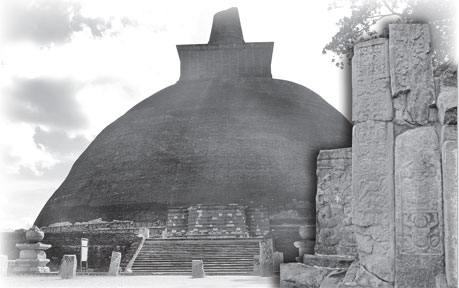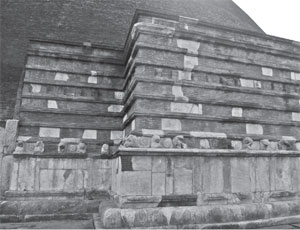|
Jethawanarama :
Great monastery in a bygone era
 'Oh!
It will be a great virtue to offer flowers to this dagoba,' said mom
looking at the empty altar at the Stupa. 'Oh!
It will be a great virtue to offer flowers to this dagoba,' said mom
looking at the empty altar at the Stupa.
“True! Jana, take those flowers, and give some to malli also,” dad
instructed. I, along with my brother, washed the lotus flowers after
removing the stems. Within seconds, flowers were ready for the offering.
 “Give us some flowers,” said mom. “Give us some flowers,” said mom.
“Putha, keep the flowers over here,” said dad. I arranged the purple
and white flowers alternating in a circle. Finished with the decoration,
I closed my eyes and chanted gathas. A few minutes might have passed
when I finally finished with chanting, I could not believe my eyes. My
beautiful flower arrangement was gone. Not a single flower on the altar
was to be seen. I looked for monkeys. Nope! No monkeys either.
“Where are the flowers?” I heard the astonished voices of mom and
dad. The answer was crystal clear. The culprit was the wind. The wind
had been ‘stealing’ all the gorgeous flowers offered to the dagoba.
We were at Jethawanarama, the only dagoba situated outside the
Mahamevna garden. Once the Stupa was the third tallest structure of the
world with a height of 400 feet, while first and second places were
taken by two pyramids in egypt. However, since those were not made of
brick, Jethwanarama was crowned as the tallest brick structure in the
world.
The present height of the stupa is 231 feet since the part of the
spiral is missing. King Mahasen commenced the construction of the great
stupa in the third century BC and his son Megavanna completed it. Later
it was dedicated to the Monks of Sagalika chapter.
Ponds and wells used by the Monks still remains around the premises
and the Department of Archaeology uncovered golden Buddha Statues and
valuable ruins. Among these treasures are priceless artefact, including
some 700,000 beads and Roman coins showing that Sri Lanka had a thriving
trade with the West from 1,600 to 1,700 AD. Jethawanarama has also been
declared as a world heritage site and is restored under the UNESCO
Cultural Triangle project.
Relic
 Part of a robe worn by the Buddha himself is the relic enshrined in
the stupa. Inside the shrine there are three statues of the Buddha and a
few statues of kings. The first statue among them is of King Mahasen.
Archaeologists rate the shrine as one of the most impressive image
houses found in Anuradhapura. Within the boundary of the Jethwanarama
complex, ruins of 15 groups of buildings have been found. When compared
with the other two monasteries in Anuradhapura, the Jethawana monastery
seemed to have enjoyed the patronage of kings on a lesser note than the
others. Part of a robe worn by the Buddha himself is the relic enshrined in
the stupa. Inside the shrine there are three statues of the Buddha and a
few statues of kings. The first statue among them is of King Mahasen.
Archaeologists rate the shrine as one of the most impressive image
houses found in Anuradhapura. Within the boundary of the Jethwanarama
complex, ruins of 15 groups of buildings have been found. When compared
with the other two monasteries in Anuradhapura, the Jethawana monastery
seemed to have enjoyed the patronage of kings on a lesser note than the
others.
As mentioned earlier, the monastery came under the Bhikkhus of the
Sagalika chapter, which had close connections with the Abayagiri Vihara.
The ruins situated around the dagoba signal that it had developed as a
separate monastery complex.
At the end of the Anuradhapura period, the Jetavana was one of the
abodes of Bhikkhus of the island while the other two were Mahavihara and
the Abayagiri. According to ancient writings, founders of Jethawanarama
were those who broke away from Abhayagiri. However, the three
fraternities said to have united during the time of king Parakramabahu
1. Like all the other Buddhist monuments, the Stupa was also destroyed
during the invasions of the Cholas. King Parakaramabahu 1 renovated the
monastery complex.
Conservation
Just like Abahayagiri, once Jethwanarama too had been covered by
shrub jungle even in the early years of the 19th century. It was in
1909, a monk had come here to clear the jungle and renovate the stupa.
Under the British patronage, the Buddhist monuments were largely
neglected. It was in 1873, after the creation of the North Central
Province, that the British Government started their mission to preserve
the ruins of Anuradhapura.
At that time, the Assistant Government Agent in Anuradhapura arranged
for the conservation of the ruins by keeping some of them clear of the
jungle. In 1890 the appointment of H.C.P. Bell as the Commissioner of
Archaeology, regular and systematic archaeological surveys at
Anuradhapura were started.
Earlier, the Government had made a few endeavours to survey, excavate
and restore some Buddhist monuments. For instance, when in 1882 a
portion of the Abayagiri Stupa collapsed, the Public Works Department
began the restoration work and on another occasion, when a Siamese
Prince donated some money, the Government began the reconstruction of
the Mirisaveti Cetiya. By the end of the 19th century, most of the
dagobas in Anuradhapura were cleared of jungle and the excavations were
completed only with respect to two dagobas in Anuradhapura.
Thanks to the efforts of the officials Stupas like Jethwanarama still
stands majestically to show us the grandeur of a bygone era.
Pix: Janani Amarasekara |

